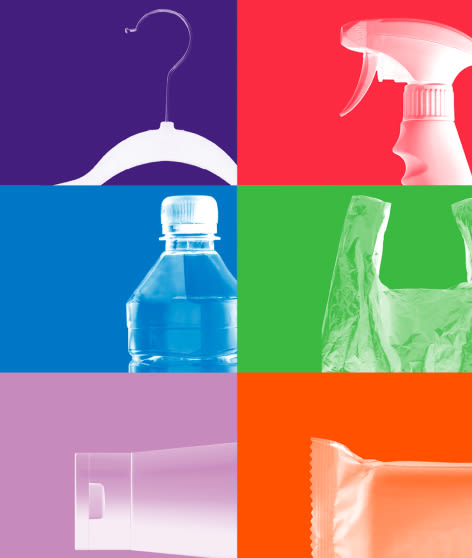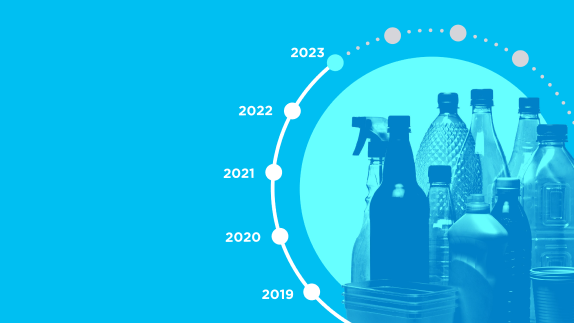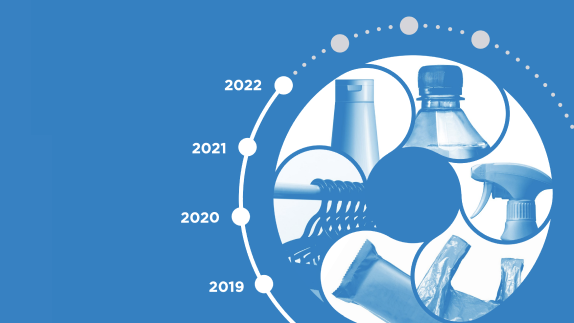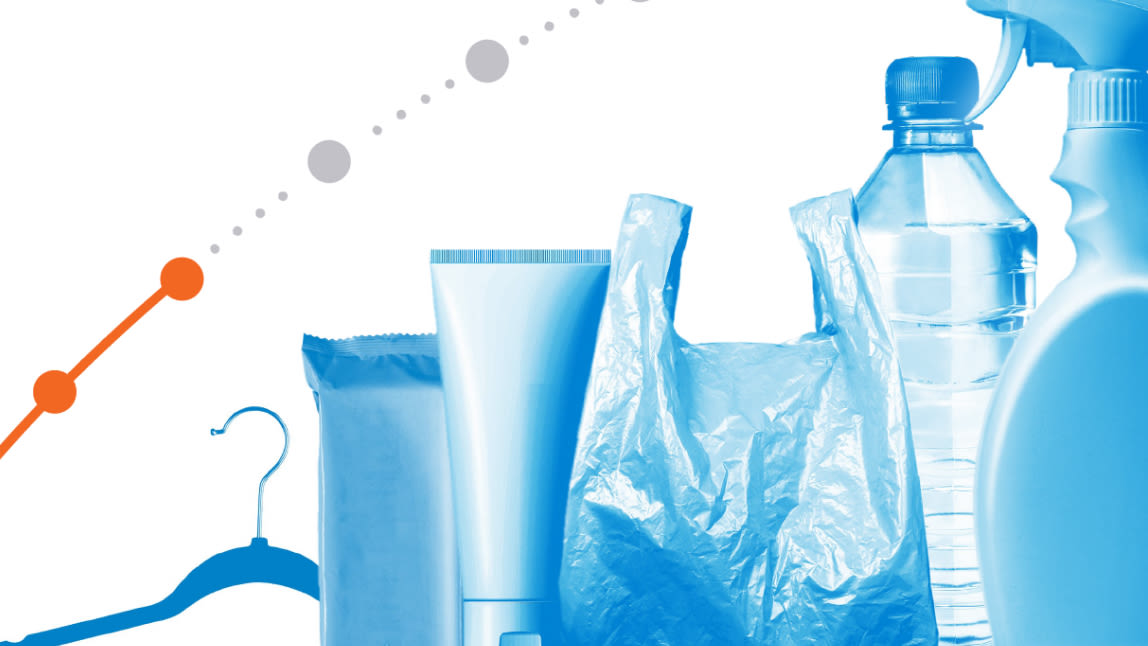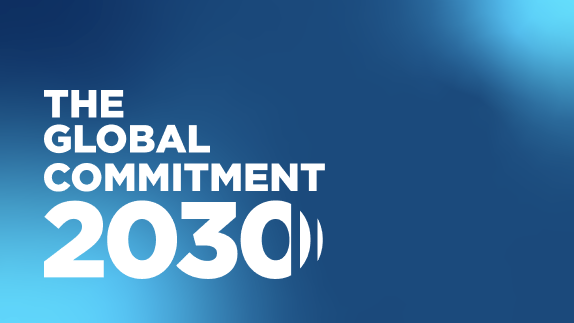Published as part of Global Commitment Progress Report 2022 by the Ellen MacArthur Foundation and UN Environment Programme
Overall trends
In 2022, 34 additional national and sub-national governments across different continents committed to join the Global Commitment. Together with existing signatories, they represent more than 1 billion people.
This year saw the introduction of mandatory quantitative targets and reporting for government signatories. Ten government signatories have already set quantitative targets, notably on collection, sorting, and recycling rates of plastic packaging that will help inform better decision-making on investments and improve the recyclabilityrecyclabilityThe ease with which a material can be recycled in practice and at scale. and reusereuseThe repeated use of a product or component for its intended purpose without significant modification. of plastic packaging.
Governments have taken a variety of actions to drive the elimination of problematic and unnecessary plastic packaging/products and foster reuse models to reduce the need for single-use plastic. This includes legal measures such as bans and restrictions but also the implementation of reuse pilots and minimum requirements for reuse solutions.
Governments have also taken measures to improve the collection, sorting, and recycling infrastructure and ensure that 100% of the plastic packaging put on the market is reusable, recyclable, or compostable (RRC). This includes introducing mandatory design requirements for all plastic packaging placed on the market, rolling out of EPR legislations, expanding collection for recycling, and investing in recycling infrastructure.
In parallel, governments have also been stimulating demand to ensure the development of an economic market for recycled plastic by establishing post-consumer recycled (PCR) content minimum thresholds and economic incentives (e.g. subsidies) or disincentives (e.g. taxes, charges).
Actions to accelerate progress
Voluntary industry efforts alone will not be enough to end plastic pollution. Policy is crucial to create the enabling conditions and incentives to successfully scale a circular economy for plastics, and a level playing field for all market participants. This is crucial to ensure all stakeholders move to action, including those that have not yet committed to do so voluntarily.
Policymakers should prioritise the elimination of unnecessary and problematic plastic packaging/products. This includes upstream policy interventions such as integrated policy packages which ensure the circular solution is also the most financially viable and practical option. Such interventions could combine, for example, subsidies for reusable packaging with bans on sachets for specific applications. By introducing reuse targets and mandatory deposit return schemes for specific types of packaging, policymakers can also foster innovation on reuse models.
Government action is essential to ensure that, where plastic packaging/products are needed, they remain in the economy and out of the environment. This includes supporting the establishment of recycling infrastructure and related incentives to collect, sort, and recyclerecycleTransform a product or component into its basic materials or substances and reprocessing them into new materials. packaging such as well-designed EPR policies. Specific actions should be complemented with a high degree of transparency on collection, sorting, and recycling rates (including targets for specific packaging types) and disclosure of fees for landfilling and incineration.
Ambition and measurement
In 2022, government signatories have been required to set quantitative targets and reporting, notably on collection, sorting, recycling rates of plastic packaging that will help inform better policy decision-making and drive the transition to a circular economycircular economyA systems solution framework that tackles global challenges like climate change, biodiversity loss, waste, and pollution. It is based on three principles, driven by design: eliminate waste and pollution, circulate products and materials (at their highest value), and regenerate nature. for plastics. To further increase the ambition level of the Global Commitment over time, government signatories have also been requested to set quantitative baselines and targets on at least two additional areas by 2023.
Trends
Of the 17 reporting government signatories, 59% have set at least one quantitative target linked to their overarching commitments, with the rest of the group currently working on establishing such targets.
In 2021, 53% of reporting government signatories were tracking quantitative information on collection, sorting, or recycling rates for plastic packaging or products. 47% have set quantitative targets for 2025.
35% of signatories have also set targets to incentivise the use of reusable, recyclable, or compostable plastic packaging and eliminate problematic and unnecessary plastic packaging/products.
Challenges faced by governments in setting and tracking quantitative targets include: lack of available data, capacity, resources for data collection and analysis, and information on alternatives to single-use plastic packaging/products. Governments have been exploring solutions to overcome these challenges, including improving data on collection and recycling performance through waste compositional analysis and digital tools.
The experience and learnings from quantitative baselines and targets set under the Global Commitment could inform the signatories on key challenges and opportunities related to reporting during the coming negotiation on the international legally binding instrument.
Elimination of problematic or unnecessary plastic packaging / products
Trends
53% of government signatories established or revised legal measures to eliminate problematic or unnecessary plastic packaging and/or products, mostly focusing on specific categories including single-use plastic straws, cutlery or tableware, bottles, and cotton buds. Public procurement was also leveraged by a number of government signatories (41%) to drive elimination of problematic or unnecessary plastic packaging and/or products.
In addition, an increasing number of government signatories are taking a more holistic approach, promoting innovation in packaging, product design (29%), or business models (41%) and the implementation of Extended Producer Responsibility (EPR) schemes (47%).
Six government signatories (35%) have set quantitative targets on the elimination of problematic or unnecessary plastic packaging and products.
Highlights
Peru banned single-use plastic bags, containers, and cups for food and beverages made of expanded polystyrene (EPS) as well as non-recyclable plastic tableware and table utensils. The country is also signing Clean Production Agreements (CPAs) with the private sector to incentivise businesses to eliminate problematic or unnecessary plastic packaging and promote innovation in packaging or product design.
New Zealand, too, approved bans on several hard-to-recycle plastic packaging categories, including drink stirrers, cotton buds, PVC preformed trays and containers, PS takeaway, and EPS food and beverage packaging.
The City of Copenhagen has been leading on the development of common criteria for circular plastic packaging in public procurement, prioritising reduction and reuse models.
Meanwhile, The Netherlands is co-funding the programme ‘CIRCO’ that activates entrepreneurs and creative professionals to (re)design products, services, and business models.
Looking at quantitative targets, Portugal aims for an 80% reduction in consumption of cups and food containers by the end of 2026, and for a 90% reduction by the end of 2030 compared to 2022. The Netherlands, too, has a target to reduce single-use packaging and products by 20% by 2025 as part of the Plastics Pact NL.
The State of Mexico aims to implement municipal ordinances in the 125 municipalities of the territory of the State of Mexico by 2025 to prohibit, disuse, or replace single-use plastics.
Encourage reuse models where relevant, to reduce the need for single-use plastic packaging/products
Trends
An increasing number of government signatories are piloting or scaling reuse solutions: 44% in 2021 compared to 38% in 2020. Other commonly used measures include the promotion of collaboration with the private sector (47%), and delivery of awareness-raising and education campaigns (29%).
Five government signatories (29%) have also set quantitative targets to encourage reuse models.
Highlights
Chile approved a bill to limit the use of a number of single-use products (such as cutlery, straws, trays, and sachets) in restaurants, hotels, bars, and other similar establishments. For on-site consumption, it bans the delivery of any single-use packaging/products of any material and mandates the use of reusable products.
Austin recently relaunched a new platform for the Austin Reuse Directory, which helps locals find where to donate, resell, buy responsibly, rent, and repairrepairOperation by which a faulty or broken product or component is returned back to a usable state to fulfil its intended use. items, while supporting the local reuse economy.
In Portugal, from 2024, establishments using plastics for the supply of ready-to-eat meals will be obliged to make reusable alternatives available to their customers, with fees attached to the packaging to foster reuse rates.
France has specified that at least 50% of its objective to decrease single-use plastic packaging by 20% by 2025 must be obtained through packaging reuse (including bulk sale, refills, and deposit return schemes).
In Portugal, businesses across a number of sectors (industry, commerce, distribution, and catering) will be required to set reuse targets by the end of 2022. In the absence of self-adopted targets, the following targets will apply: at least 20% by January 2025 and at least 50% by January 2030 of the annual volume of beverages to be delivered through reusable packaging.
Incentivising the use of reusable, recyclable, or compostable plastic packaging
Trends
In 2021, governments incentivised reusable, recyclable, or compostable plastics packaging primarily through developing regulations, standards, or guidelines (35%) and establishing EPR schemes (35%). In addition, governments reported efforts to introduce labelling schemes, aiming to inform consumers of how to segregate and recycle plastic products/packaging.
Six government signatories (35%) have set quantitative targets to incentivise the use of reusable, recyclable, or compostable plastic packaging.
Highlights
The City of Copenhagen updated labelling on containers for household recyclable waste with national pictograms.
New Zealand is encouraging industry adoption of the Australasian Recycling Label, an on-pack label that helps consumers in Australia and New Zealand to correctly recycle their household packaging.
The United Kingdom set a target that 100% of plastic packaging will be recyclable or reusable by 2025.
The City of Copenhagen aims to engage with more than 70 different businesses between 2021 and 2024 to discuss design-for-recycling, and challenges for automatic sorting caused by specific colours, labels, shapes, and material compositions.
Increase collection, sorting, and recycling rates, and facilitating the establishment of the necessary infrastructure and related funding mechanisms
Trends
In 2021, 59% of governments invested in collection and recycling infrastructure, helping to drive up collection and recycling rates. In addition to investments, 76% are promoting collection, sorting, reuse, and/or recycling schemes.
53% of reporting government signatories are tracking quantitative information on plastic collected, sorted, recycled, or composted and 47% have targets to increase these volumes by 2025.
Setting targets and tracking data around collection, sorting, and compostingcompostingMicrobial breakdown of organic matter in the presence of oxygen. rates for plastic packaging or products is particularly important due to the current lack of data on this area and the need to scale up infrastructure.
Highlights
The United Kingdom launched the Household Waste Recycling Collaborative Change Programme in Northern Ireland, providing GBP 23 million to support councils in improving recycling services and achieve Recycling Collaborative Change recycling targets. The City of Copenhagen invested DKK 1.5 million to pilot test Holy Grail 2.0, aiming to increase the quality of recycling and of recycled material through intelligent sorting with digital watermarks.
Scotland’s deposit return scheme system is due to launch on 16 August 2023, with a collection target of 90% of containers by 2024. Recyclable plastic film and flexible packaging is to be collected for recycling by March 2027.
The City of Toluca implemented a programme through which citizens can exchange recyclable waste, including plastic, for vouchers that can be used to purchase consumer items for the basic basket.
The United Kingdom announced their intention to set a target of 51% of plastic packaging in scope of their Extended Producer Responsibility (EPR) scheme to be recycled by 2024, increasing to 62% by 2030. In 2021, 44% of the 2,514,000 tonnes of plastic packaging waste generated in the UK was recycled.
Portugal plans to amend its existing decree on waste management to integrate a recycling target for plastic packaging placed in the market of 50% by end of 2025, and The Netherlands aims to increase their rate of plastic reused or recycled to 50% by 2025.
Governments implementing EPR schemes
Trends
In addition to the above measures, governments are also focusing on Extended Producer Responsibility (EPR) schemes to ensure finance for after-use systems and improve collection rates: 67% of national governments are already implementing EPR schemes and 89% are planning to do so by 2025.
Highlights
Rwanda initiated the development of EPR guidelines that will be completed by the Rwanda Environment Management Authority.
The United Kingdom announced the introduction of EPR in 2024. Based on data reported in 2024, modulated fees based on recyclability will be introduced from 2025, to incentivise producers to use packaging and packaging materials that can be recycled.
Scotland is working on the introduction of EPR for packaging in a phased manner from 2024 onwards. Annual targets will be set for the six packaging materials (plastic, paper/card, steel, aluminium, glass, wood) for each year from 2024 to 2030.
Stimulating the demand for recycled plastics
Trends
Governments are using a mix of instruments to stimulate the demand for recycled plastics. These include introducing PCR content minimum thresholds (24% of reporting government signatories), establishing EPR schemes (24%), supporting products containing recycled plastics through public procurement (18%), and introducing or revising economic incentives (e.g. subsidies) or disincentives (e.g. taxes, charges) (18%).
Four of the reporting government signatories (24%) have set quantitative targets linked to their commitment to stimulate the demand for recycled plastics.
Highlights
Peru enforced a minimum threshold of 15% recycled material in PET bottles for beverages for human consumption, cleaning products, and personal care.
In the United Kingdom, a GBP 200 per tonne tax on plastic packaging with less than 30% recycled content has been introduced since April 2022. It is estimated to lead to around a 40% increase in recycled plastic being used in packaging in 2022/2023, with a potential saving of nearly 200,000 tonnes of CO2.
Chile has prioritised the modification of health regulations to incorporate recycled plastic in food packaging.
Portugal set a target of at least 25% recycled plastic into PET bottles by 2025, increasing to 30% by 2030.
In The Netherlands, the Plastics Pact NL set a target of at least 35% recycled content in new products and packaging by 2025.
Current and future Global Commitment government signatories
About these government insights
This document presents insights and data on the progress made by the government signatories listed below to achieve their commitments on plastics. This document is part of the 2022 Global Commitment Progress Report.
About the Global Commitment
The Global Commitment is an initiative led by the Ellen MacArthur Foundation, in collaboration with the UN Environment Programme. Through the Global Commitment, businesses and governments commit to change how we produce, use, and reuse plastic. They will work to eliminate the plastic items we don’t need; innovate so all plastic we do need is designed to be safely reused, recycled, or composted; and circulate everything we use to keep it in the economy and out of the environment. Learn more
Global Commitment governments signatories reporting in this sector
City of Austin, Texas, US
City of Buenos Aires (Gobierno de la Ciudad de Buenos Aires), Argentina
City of São Paulo (São Paulo City Hall), Brazil
City of Toluca, Mexico
Government of Chile
Government of Rwanda
Government of the United Kingdom
Ministry for the Environment, New Zealand
Ministry of Environment and Climate Action, Portugal
Ministry of the Environment of the Government of the State of Mexico, Mexico
Ministry of the Environment, Peru
Scottish Government,United Kingdom
The City of Copenhagen, Denmark
The City of Ljubljana, Slovenia
The Ministry of Infrastructure and Water Management, the Netherlands



